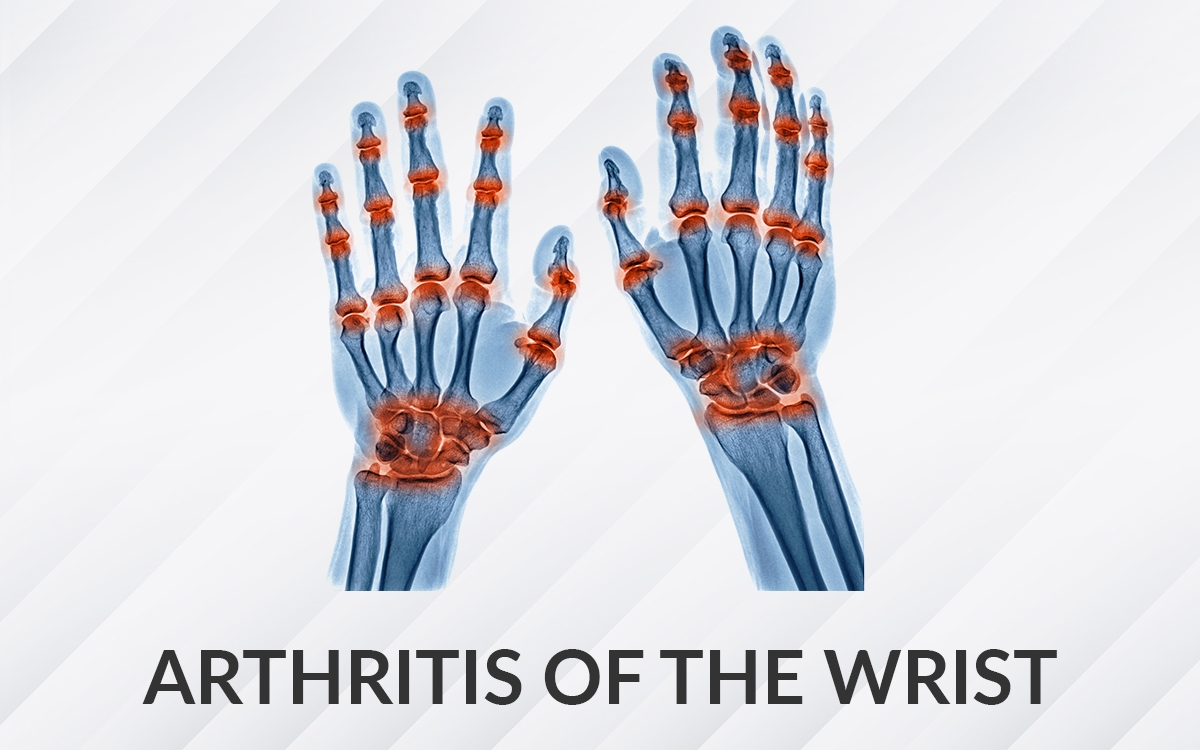
Summary
Causes
- Wrist Osteoarthritis
Due to normal wear and tear - Rheumatoid Arthritis
Autoimmune disease - Posttraumatic Arthritis
Injury such as a broken wrist bone or a torn ligament
Symptoms
- Pain
- Swelling
- Stiffness
- Loss of motion
- Clicking
- Crepitus
- Grinding and weakness
Treatment
- Non-Operative
- Splints
- Home adaptations
- Activity modifications
- Exercises
- Steroid injections
- Surgical Options
- Proximal row carpectomy
- Partial wrist fusion
- Total wrist fusion
- Total wrist replacement (Arthroplasty)
What is Arthritis of the Wrist?
The wrist is made up of many small joints and inflammation in these areas can be a sign of arthritis. The cartilage in the wrist bones gets destroyed in arthritis causing the bones to rub against each other.
What are the types of Wrist Arthritis?
There are four types of arthritis that can affect the wrist –
1. Osteoarthritis (OA)
2. Rheumatoid arthritis (RA)
3. Post traumatic arthritis (PA)
4. Psoriatic arthritis which is an inflammatory skin and joint disease
What is Wrist Osteoarthritis?
Osteoarthritis can develop due to normal wear and tear (degenerative joint disease). Here the smooth articular cartilage that covers the ends of the bones gradually wears away over time. As the cartilage does not have the ability to heal or regenerate; this results in bone rubbing on bone which in turn causes pain, stiffness and loss of motion.
What is Rheumatoid Arthritis?
It is an autoimmune disease which means the body’s own immune system starts attacking its tissues and joints. This results in damage to cartilage, ligaments and soft tissues which results in erosion and deformity to the joints. People with RA are more likely to have arthritis in their wrist. Over time it may become hard to bend your wrist or perform daily activities. People with RA may also feel fatigue, general discomfort, fever, lack of appetite and weakness.
What is Posttraumatic Arthritis?
This develops after an injury such as a broken wrist bone or a torn ligament. Trauma can cause a direct injury to the cartilage. Torn ligament affects the way bones move together which in turn causes a slow progressive wearing of the cartilage which eventually results in arthritis. Post traumatic arthritis can develop after many years after the initial injury. Despite proper treatment, an injured joint depending on the damage to cartilage at the time of injury can become arthritic over time.
What are the symptoms of Wrist Arthritis?
Not all patients with wrist arthritis will experience symptoms. When they do occur the severity of symptoms vary greatly from patient to patient. Symptoms may include pain, swelling, stiffness, loss of motion, clicking, crepitus, grinding and weakness.
What will happen when I see my doctor?
The doctor will take your medical history and then examine your wrist. They may then order further tests like x-rays, Blood tests, CT scans to look at the arthritis.
What does the treatment involve?
There is no cure for arthritis but there are a number of treatments that may help relieve the pain and loss of function. Initially your doctor will try non-operative treatment including sessions with a hand therapist or an occupational therapist. They may, depending on the type of arthritis make splints for you, home adaptations, activity modifications and do exercises. The next line of treatment will be steroid injections.
If non-surgical treatment doesn’t help you with pain or your quality of life, then you will be offered a surgery. There are various options like proximal row carpectomy in which your doctor removes the three carpal bones from your wrist and you can also be offered a partial or a total wrist fusion or a wrist replacement. The idea is to fuse together the bones so that they can heal into a single solid bone. The theory behind fusion is; if the painful bones do not move they should not hurt.
Partial wrist fusion
Some carpal bones will be fused. This means the other healthy joints will be preserved to give you some wrist motion.
Total wrist fusion
If your arthritis is extensive then you will be offered a complete wrist fusion which means all the carpal bones will be fused together along with the radius (one of the bones in the forearm). Although you lose your wrist motion but the motion in your thumb, fingers and forearm rotation will be preserved.
Total wrist replacement (Arthroplasty)
In a total wrist replacement, the doctor will remove the damaged cartilage and the carpal bones in your wrist and replace it with metal and plastic joint surfaces. This will relieve the pain and give you wrist motion.

69 years male, wrist arthritis after scapholunate ligament rupture

Scaphoid bone removed and 4 corner fusion ( partial fusion ) done

24 years female, x rays and CT scan confirms Kienbock’s disease

Lunate bone removed and scaphocapitate fusion ( partial fusion ) done

51 year old male , manual labourer, x ray and wrist scope shows SNAC 4 ( scaphoid nonunion advanced collapse ) wrist

Total wrist fusion done

73 years female , x rays shows wrist arthritis

Post operative wrist replacement x rays
BMI Chelsfield Park Hospital
Bucks Cross Road Chelsfield ORPINGTON BR6 7RG
01689 877855
BMI The Blackheath Hospital
40-42 Lee Terrace Blackheath LONDON SE3 9UD
020 8318 7722
BMI The Sloane Hospital
125 Albemarle Road BECKENHAM BR3 5HS
020 8466 4000
Princess Royal University Hospital
Farnborough Common ORPINGTON BR6 8ND
01689 863223



